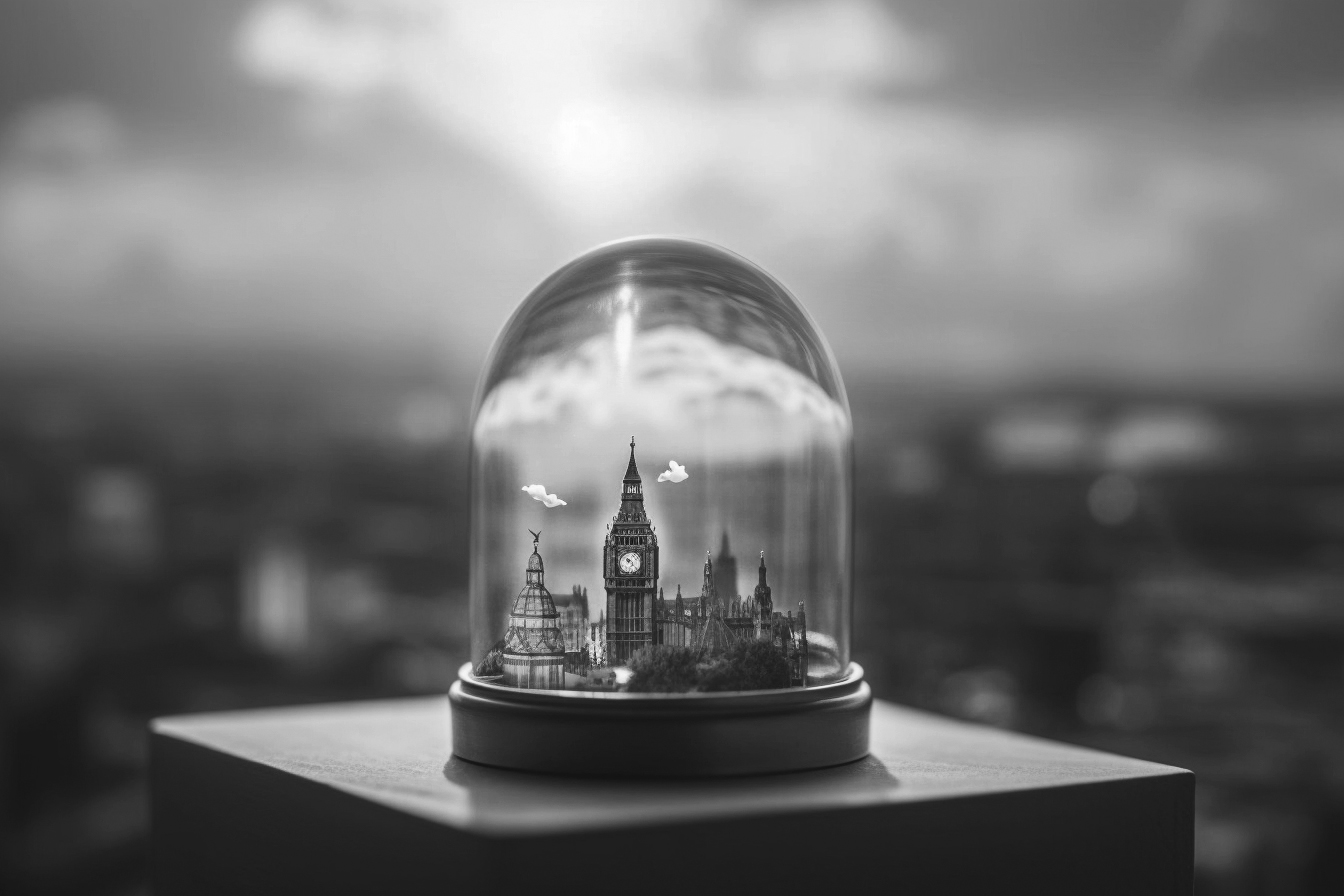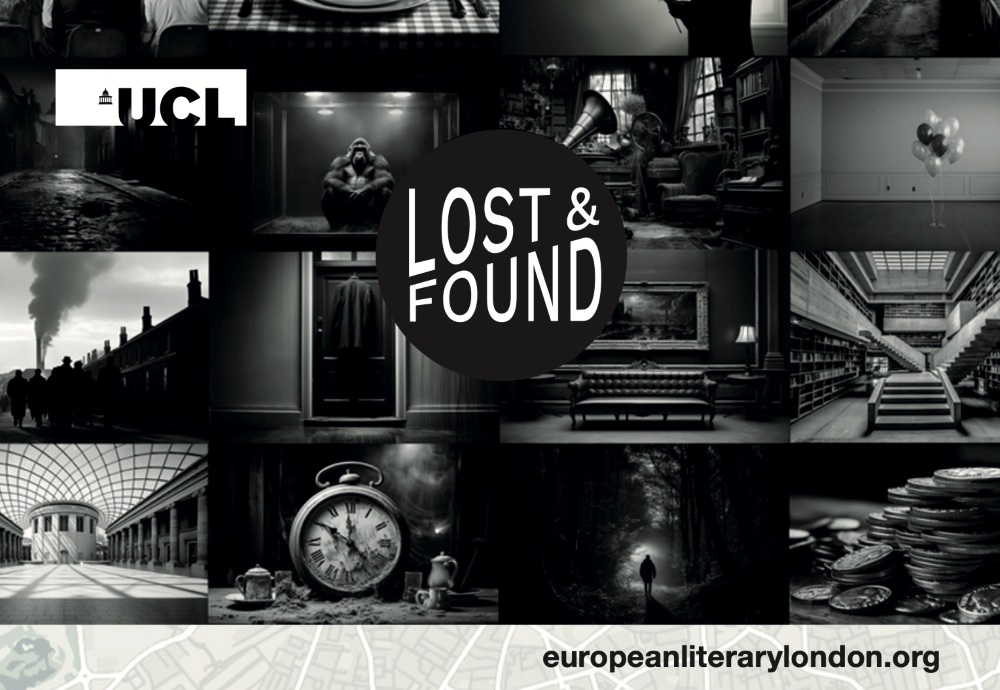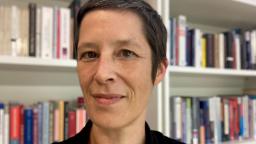The Seething, Teeming, Unpredictable City
Mapping the Literary Traces Left by European Writers in London
by Uta Staiger
Es ist entsetzlich! Es ist toll! Ich bin confus und verdreht! London ist das grandioseste und complicirteste Ungeheuer, das die Welt trägt.
It is fearful! It is mad! I am quite giddy and confused. London is the grandest and most complicated monster on the face of the earth.[1]
Felix Mendelssohn, the German composer, pianist and conductor of the early Romantic period, had quite the visceral reaction to London when he first visited in 1829. His impressions – penned in a letter to his sister Fanny Mendelssohn, herself an outstanding composer and musician – brim with intensity, perplexity and ultimately enthusiasm for the city and its inhabitants. The feeling, as we know, was speedily returned. Mendelssohn came to be much loved and admired in London’s musical circles and beyond, with some of his compositions, not least those for Shakespeare’s A Midsummer Night’s Dream, now virtually part of the national canon. He even charmed the royal household. As Queen Victoria declared in a diary entry: ‘Really I have never heard anything so beautiful’.

Mendelssohn may not have had much ground to compare metropolises, of course. Although well-travelled in Germany, Austria, Switzerland and Italy, London was already the biggest and busiest city in Europe by far. With just under two million inhabitants, it was almost twice what it had been only thirty years earlier, and on its way to grow to 8 million in the space of another century. It was also ten times the size of Berlin, where Mendelssohn had his main residence, and twenty times the size of his city of birth, Hamburg. London outsized, outdid, outshone everything else urban in 19th century Europe. A fulcrum of empire, hub of industrialisation, hometown of parliamentarisation, and the place for print, press and book production. Sprawling technologies, relative freedom and vast inequality. And indeed, quickly recovered from the initial jolt, Mendelssohn would return to the British capital another nine times in his very short life: there was ‘no question that that smoky nest is my preferred city and will remain so’, he would come to write.[2]
Giddiness is not a surprising reaction to London from one of the foremost representatives of Romanticism, an artistic movement that exalted feeling and the imagination. A fierce literary, aural and visual ingenuity would seep into Mendelssohn’s musical language. Place certainly impressed the composer: his Hebrides overture, composed in 1830 during a visit to the Western Isles of Scotland, is often described as a tone-poem. An emerging genre in Romanticism, the symphonic or tone poem provided greater structural freedom for the composer to express literary or narrative elements musically. Mendelssohn’s The Hebrides is an almost illustrative composition, a tonal form of story-telling, as it orchestrally renders places, encounters, journeys. Including his attempt to capture in music ‘oil and seagulls and dead fish’, as he described it in another letter to his sister.
Not unlike the Hebridean dead fish, Mendelssohn’s use of Ungeheuer to describe his first encounter with London is rather interesting. As a noun it is best rendered in English as ‘monster’, but its adjectival or adverbial use in German is more complex than ‘monstrous’. Like its English counterpart, ungeheuer too slides most easily into a negative figurative use, gesturing towards something ugly, horrible, indeed potentially dangerous. But in German this is, to an extent, because the prefix un- turns the word into the opposite of geheuer, a term whose etymological roots signified ‘belonging to the household’ and therefore ‘familiar, pleasant’. Indeed, not dissimilar to the concept of unheimlich (uncanny), so beloved by another German resident of London, the father of psychoanalysis Sigmund Freud, geheuer today exists only in negation. Something ungeheuer or nicht geheuer expresses things unsafe, unsure, unhomely, treacherous: related to an unknowable other.
To be sure, ‘monstrous’ is not exactly a rare descriptor of life in great cities. A century before Mendelssohn, to pick just one, English novelist, pamphleteer and merchant Daniel Defoe also called London ‘this great and monstrous Thing’. And almost a century after Mendelssohn, so does Joseph Conrad, originally Józef Teodor Konrad Korzeniowski, of Polish origin and one of the greats of English-language literature: ‘a monstrous town more populous than some continents and in its man-made might as if indifferent to heaven’s frowns and smiles’.[3] But might it be also because the city is both home and not, because it is, as per a much later definition, full of the unknown, of the strange, and, of course, of strangers?
And yet, ungeheuer also has an additional, potentially positive connotation, which Conrad’s invocation of ‘might’ already gestures towards. This is because it can also describe an object, person or activity as exceptionally large: immense, outsized, enormous. Simultaneously extensive and intense – and thus simply and excitingly larger than life. Or, in the words of intrepid traveller Fredrika Bremer:
det stora, fulla, brusande, nu mer än någonsin överfulla, livfulla, brusande London.
London, vast, teeming, roaring, now more overcrowded, lively and turbulent than ever.[4]
In German adjectival or adverbial use, ungeheuer expresses an intensifying force, which enlarges the significance of the noun or verb it accompanies – it increases its appealing connotation as it expands its derogatory one. As such, one can read the monstruous not exclusively in negative fashion: it encapsulates the convoluted-yet-grandiose nature of the city he encountered.
The city is our very own repository of fantasies and projections, desires and nightmares. As such it can be almost a text of its own, legible to the attentive reader or walker.
We find this conjunction of opposites characteristic of the way cities have been appraised in the history of economic, social and political thought. Swedish writer, historian, and philosopher Erik Gustaf Geijer articulated the combination of extremes during a visit around the same time:
Yr i hufvudet befann jag mig slutligen i mitt rum, — Brunets Hotel, Leicester Square, — allena med min kappsäck; och tyckte mig instängd i en verld af tegelsten och ensam bland en million menniskor. Les extrêmes se touchent. Jag har aldrig haft lifligare begrepp om en ödemark än den stund jag först befann mig midt i den folkrikaste stad i Europa.
Disoriented, I finally found myself in my room, – Brunet's Hotel, Leicester Square, — alone with my portmanteau. I seemed to be shut-up in a world of brick, all alone amongst a million people. Les extrêmes se touchent. I have never had a more vivid impression of a wasteland than in that moment when I found myself at the centre of the most populous city in Europe.[5]
Geijer foreshadows the analyses of Karl Marx and his collaborator Friedrich Engels, two other exiles who made London their home, and who saw in ‘the frantic bustle of the great city’ nothing but ‘the disintegration of society into individuals’. For Engels, the metropolis was the locus classicus of the modern capitalist system, which made ‘human society ... split into its component atoms’.[6] Yet his near-contemporary Max Weber, interested in the political consequences of early modern urban economies, also identified the liberating forces of urbanity. Despite the persistence of certain other constraints, if rather circumventing questions of conflict and inequality, Weber also identified in European modernity the possibility of freeing oneself from social strictures: ‘city air makes us free’ – Stadtluft macht frei – he quoted.[7] Weber’s student Georg Simmel takes in a bit of both perspectives, as he worries about the detrimental impact of the surging, kaleidoscopic nature of individualised urban life, in which ‘the rapid telescoping of changing images’ may stultify those making their life in the city.[8]
Clearly, in our 21st century experiences of urbanity we recognise both the freedoms and the constraints. The coexistence of multiple possible affiliations, so characteristic of the big city, carries with it the opportunity to belong to none. It may do away with the dominance of a single frame – and thus make it possible to forge one’s own, potentially creative, path – yet social codes and class limits persist. Similarly, we recognise, in the footsteps of Walter Benjamin, that in its modern incarnation, the city may well be physical space and social order and assault on the senses. Yet it is also symbolic, an imagined landscape, in which grand architectures and minutiae of built forms, the magnificent and the mundane, allow us to capture something otherwise intangible about our past and the present. The city is our very own repository of fantasies and projections, desires and nightmares. As such it can be almost a text of its own, legible to the attentive reader or walker.
What happens when we map literary works – when we map the mapping of the world?
Now as then, the question arises just how one might best capture this vastly complex Thing made of innumerable intersecting planes – architectural, social, economic, identitarian, governmental, fantastic. In this swirl and rush of immediate impressions, is there any way at all to capture the chaos and fluidity of urban life? Mendelssohn himself, in the early 19th century, was acutely aware of the dilemma:
Kaum weiß ich mich noch der Hauptsachen zu entsinnen und doch darf ich kein Tagebuch führen, sonst würde ich wieder etwas weniger erleben müssen; das will ich aber nicht, sondern Alles mitnehmen, was sich mir darbietet. Es geht um mich herum wie in einem Strudel und dreht sich und reißt mich fort.
I hardly remember the chief events, and yet I dare not keep a diary, for then I should have to see less of life, and that I do not wish. On the contrary, I wish to take everything that offers itself. Things toss and whirl about me as if I were in a vortex, and I am whirled along with it.
It is impossible, he seems to suggest, to halt the immediacy and polyphony of urban experience and transpose it into rationally ordered thought. It would mean loosening your grip on it all. Step out of the vortex to observe, he writes to his sister, and you will not just miss out but somehow lose sight of the Ungeheuerlichkeit of urban experience.
Mendelssohn articulates in the early 19th century what Michel de Certeau, a French philosopher, sociologist and theologian, would set up as key contrast in the late 20th century. De Certeau famously thought there were two very distinct ways we can conceive of and represent cities. One is the rational, ‘planned and readable’ city as if spread out on a map: bird-like, as from a divine point of view, abstracting the complexity of urban reality into a manageable representation, a map, a grid. If we assume this bird or God-like position today, courtesy of state-of-the-art aviation technology, we may understand the allure of such comprehensibility. Yet miss something else entirely. The seething, teeming, unpredictable city we experience on street level, can only be observed from the ground: from within the vortex, as it were. What’s more, unaware of their practice, the walkers and dwellers caught up in the vortex are its producers at the same time: as they live and traverse urban fabric, they write the city.[9] It is a contrast that maps quite neatly onto the idea of a ‘second, poetic geography’ (this is also de Certeau) that sits on top of our lived one. The city as it is written in texts, represented in literature. Think of the omniscient narrator zooming out of ‘the geography of the literal’ to take the reader by the hand, throw a panoramic glance upon the setting, only to dive back into the thick of it, pulling us into different directions, entangling us in webs of interaction, taking us down some paths and averting, discarding others.
Might it in fact not be the writer’s capacity for combining partiality with universality – of zigzagging between the precise, immersive, minute and peculiar detail to the sweeping, diachronic vision – which most accurately renders the dual nature of the city, and our experience thereof?[10] If, as we have touched on above, we can understand space as semiotic or symbolic – if we approach it as we would text – can we not also recognise how text produces (an experience of) space? Might we even postulate that there is a certain reciprocity to the way setting shapes text – and text shapes setting – from novels to diaries, letters to poetry, essays to memoirs? If literature is a practice of mapping the world, as Malcolm Bradbury phrased it, if literary works ‘point us to a distant “there” by way of the illusion of a “here”’,[11] what happens when we map literary works – when we map the mapping of the world?
The map encourages us to reflect, critically or playfully, on the role of the city as a place where journeys and languages intersect; where people and cultures meet and are transformed. Where writing seeps off the page and in its own way makes, or remakes, our world.
It is these questions that tempted us – a team at the UCL European Institute – to create the European literary map of London, to which this special issue is linked. An originally digital, interactive map, the project seeks to uncover and chart the literary traces left by novelists, poets, visual artists, musicians, philosophers and scientists from across Europe who have come to London throughout centuries. Who, speaking over twenty-five different languages, write in them about London. And who we in turn think about, research, contextualise, locate and align with a set of six cross-cutting themes. These themes, naturally, are each made up of conceptual oppositional pairs – freedom and constraint, poverty and plenty, phantasy and banality, familiar and other, noise and nature, pleasure and disgust. By so doing, we posit, the excerpts we are mapping – almost a hundred already – reveal a London and a Europe of the imagination. The map encourages us to reflect, critically or playfully, on the role of the city as a place where journeys and languages intersect; where people and cultures meet and are transformed. Where writing seeps off the page and in its own way makes, or remakes, our world.
Now, cartographies continue to intrigue us with a particular lure: ‘maps entice and fascinate’, as one critic put it, because ‘they whisper implicit promises of comprehension, of clarity, of transparency, and of order.’[12] And of course who doesn’t enjoy the quasi-divine view from above? Only, of course, this is not the full story. Cartographies are also constructions of knowledge. By their very operation, they contain biases and blind points, rhetorical and ideological choices, at times implicit, at times explicit. Maps, so critical cartography has shown us, tell stories their own way.

Yet being aware of this, playing with the resulting associations, tensions, conceptual opposites – making the operation of mapping itself visible – can reveal as much as hide. After all, just as they abstract, maps can also incite us. They make us question and interrogate what we see, explore the data thus presented, consider other vantage points.[13] This may be particularly productive at a time when the ready availability of GPS-facilitated maps changes so profoundly the way we navigate cities. Screen in hand, the map’s assumed flawlessness also dulls the urban experience. A means to orient ourselves, to efficiently dominate any and all environments, the digital map shields us from the haphazardness, the haptic and the provisional. It buffers us against the typical chance encounter which once may have made all the difference between losing and finding one’s way – and possibly, oneself. So, if a map of literary mapping turns its own practice on its head, makes us stumble across others’ points of view, practices, irritation, mystification, if it makes us bump into stories within and about the places they describe, from authors who have been there before us, well, it might just replicate some of the serendipities of urban rambling. Rather than sever us from actuality, such a map might peel back layers of historical encounters with actualities, real or imagined, over time – and thus tickle not dull.
The effect of the coincidental that comes with such discoveries, and their fortuitous connections across a map, can be illuminating, also critically so. Yes, it may be a 21st century version of armchair travelling, as Cervantes’ Don Quixote imagines it wittily (‘without leaving their chambers or the confines of the court, [the courtiers] stroll all over the world just by perusing a map, which does not cost them a penny or cause them to suffer any heat or cold, or hunger or thirst’). It might even lead us to conclude, as the protagonist of French 19th century writer J.-K. Huysman’s À Rebours did, that the imaginary journey was all that was needed? ‘Ultimately, I have experienced and seen what I wanted to experience and see. […] what an aberration of mine it was […] to have believed, like a complete novice, that there was any need for or curiosity or interest in making a journey?’.[14] But playing with maps may do the exact opposite too. It might allow the modern-day map-reader to engage in that sense of enlarged subjectivity that brings us into temporary alignment (or utter opposition) with others we never have and never will meet. Writers who bring to the place we both experience, across time, their very own linguistic, personal, historical baggage. With whom we might even create, along the way, something of ‘a sentimental London citizenship’, as Spanish writer Manuel Chaves Nogales put in the 1940s.[15]
Curiously, this map of European literary London also ended up jumping off the screen and out of its virtual reality, to dive back into physicality. In 2023-24, having scrolled the virtual space of online mapping, map enthusiasts could also dip into a large exhibition, which we curated for UCL’s main building, the Cloisters. There, they were invited to trespass over a large vinyl floor map of London, lose themselves in textual excerpts, jot down their own response, listen to an audio installation, and generally create their own cognitive pathways through this multilayered London. Since then, the European Literary Map of London has also gone travelling – fittingly so, in Europe. Supported by the UK’s Foreign, Commonwealth and Development Office, four versions now tour Belgium, Germany, Spain and Sweden, courtesy of the British embassies in their respective capitals. We have also invited contemporary European writers to engage with the map, through the European Writers' Festival at the British Library, co-curated by the European Literature Network and the European Union National Institutes of Culture (EUNIC) in London. And through a Writer in Residence Scheme, which has brought authors writing across several languages to London for an intense, four-week residence at UCL.
The current issue of Swedish Book Review arises from this project. It brings together texts – fact and fiction, letters and poems – written by Swedish writers across a range of backgrounds, who wrote about their London. Alongside newly commissioned translations, interviews and commentaries, they represent a sample of entries as they exist on the European Literary Map of London. Snippets of experience, fragments of smells, touch, thought as they rubbed against the traveller, imaginary or real. This is storytelling across time and space, across contradictions and concepts, genres and expectations. We hope you enjoy it – immensely.
[1] For more about the excerpt, see: https://www.europeanliterarylondon.org/feature/f3b9efda-a5fa-463f-a833-178f17f45c9f/german
[2] See https://www.english-heritage.org.uk/visit/blue-plaques/felix-mendelssohn/
[3] Conrad, Joseph. The Secret Agent (New York: Anchor Books/Doubleday 1953), p. 11. The quote is from the author’s note. See also: https://www.europeanliterarylondon.org/feature/65834b0a-ece9-4e58-8aee-2033814285e5/english.
[4] For more about the excerpt, see: https://www.europeanliterarylondon.org/feature/eb676fd4-cb67-4df6-843d-0147f24bd87b/swedish-2
[5] For more about the excerpt, see: https://www.europeanliterarylondon.org/feature/4617b629-f6fc-4ab7-93dc-dc6261237c8c/swedish
[6] Engels, Friedrich. The Condition of the Working Class in England. Translated by W. O. Henderson and W. H. Chaloner. (Stanford: Stanford University Press 1958), pp. 30–1.
[7] Weber, Max. ‘The Nature of the City.’ In Perspectives on Urban Society. Edited by Efren N. Padilla. (Boston, MA: Allyn & Bacon, 2006).
[8] Simmel, Georg. ‘The Metropolis and Mental Life.’ Chapter 1 in The Blackwell City Reader. Edited by Gary Bridge and Sophie Watson (Malden, MA: Blackwell 2002), p. 12. For an excellent overview of literature on the city, and the city in literature, see Lawrence Manley’s introduction to The Cambridge Companion to the Literature of London (Cambridge: CUP 2011).
[9] De Certeau, Michel .‘Practices of Space.’ In On Signs. Edited by Marshall Blonsky. (Baltimore: John Hopkins University Press 1985), p. 124.
[10] See West, Shearer. ‘London in Victorian visual culture.’ In The Cambridge Companion to the Literature of London. Edited by Lawrence Manley (Cambridge: CUP 2011), pp. 163-64.
[11] Bradbury, Malcolm (ed.), The Atlas of Literature (London: De Agostini Editions 1996), p. 8 and Bray, Patrick. ‘Conceptualizing the Novel Map: Nineteenth-Century French Literary Cartography’, in Literature and Cartography: Theories, Histories, Genres. Edited by A. Engberg-Pedersen (Cambridge: MIT Press 2017), p. 282
[12] Engberg-Pedersen, A. I’ntroduction—Estranging the Map: On Literature and Cartography’, in Literature and Cartography: Theories, Histories, Genres. Edited by A. Engberg-Pedersen (Cambridge: MIT Press 2017), p. 1.
[13] (Peter Turchi, Maps of the Imagination 11)
[14] https://www.europeanliterarylondon.org/feature/042a96ba-1b86-47a2-b517-1d2d90184d08/french
[15] https://www.europeanliterarylondon.org/feature/079b95b5-9bd1-463c-84fd-a33d0f3d59b5/spanish

Uta Staiger
Uta Staiger is Associate Professor of European Studies and director of the European Institute at UCL, a Jean Monnet Centre of Excellence. She is also Global Strategic Academic Advisor (Europe), a strategic role shaping UCL engagement with the European Higher Education sector. Uta’s research sits at the intersection of modern European thought, culture, and politics.
